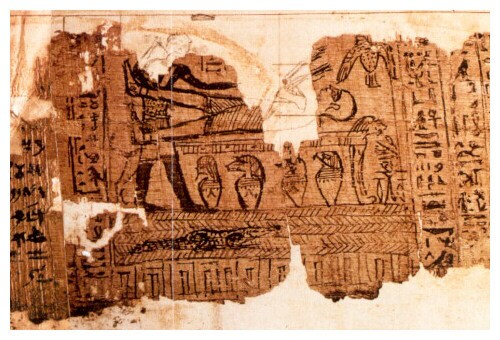
This week, the Church released a new essay on the historicity and translation of the Book of Abraham. While there is much that we don’t know about this ancient book of scripture, based on the history, there are some things we can deduce from clues in the text itself, contemporary papyri, and eyewitnesses of the papyri:
- The Saints originally possessed two papyri scrolls, one written beautifully by a well-trained scribe, and the other less well done.
- The well written scroll was apparently associated with the Book of Joseph. Much, perhaps all, of what was described of this scroll we no longer have.
- The less well-written but longer scroll was associated with the Book of Abraham. We do not know if:
- the Book of Abraham was translated from a portion of the scroll (like the Book of Mormon),
- if seeing the scroll brought about a revealed scriptural text (like the Book of Moses), or if it brought about seeing a text in vision (like the parchment of John), or
- if some combination of these things or another inspired process altogether served as the means of bringing us the divinely inspired Book of Abraham.
- The Saints felt free to speculate on the meaning of the various Egyptian vignettes. Their personal opinions and interpretations are just that: opinions and speculation.
- Joseph Smith provided interpretations of some of the drawings associated with the papyri. However, we do not know whether he was providing us with interpretations that:
- ancient Egyptians in general may have associated with them,
- a specific group of ancient Egyptians familiar with Abraham would have interpreted them,
- a group of ancient Jews would have interpreted them, or
- we need to interpret them as regardless of how ancient peoples viewed them.
- At some point (almost certainly in Kirtland) some fragments of the papyri were cut off, glued to paper, and mounted in framed glass. Some of these fragments may have come from the long scroll. After these fragments had been mounted, witnesses continued to refer to the remainder of the long roll as the source of the Book of Abraham. Thus, the existing fragments, which were mounted and framed, are not the source of the Book of Abraham.
- These mounted fragments were thought by many to contain the writing of Abraham. Apparently the presumption must have been made that since they came from the scroll which was associated with the Book of Abraham, ergo all the writing on that scroll pertained to Abraham.
- When the text adjacent to the Sacrifice of Abraham Vignette was translated, it was clearly a fairly common Egyptian funerary text known as the Book of Breathings. After much of that “book” was cut off, that roll was still regarded as the “long roll,” in contrast with the second “short” roll, which likely contained the Egyptian “Book of the Dead,” a standard text which is actually typically substantially longer than the Book of Breathings. This indicates that the long roll Joseph had, which contained the Book of Breathings, must have had more than just that text.
- While we know that the Book of Abraham was received by inspiration and is true scripture, we do not know anything about things that were said regarding the rest of the papyri. Presumably the Lord inspired the Prophet in regards to his translation, but he very well may have been left to his own mechanisms to surmise things about the rest of the papyri.
- Lucy Mack Smith frequently showed visitors the mummies and papyri that Joseph Smith owned, and explained to them about the Book of Abraham. She seems to have a translation glued into a book that she exhibited to her patrons.
In the end, while there are many more questions we must answer, the eyewitness accounts lead to the conclusion that the few mounted fragments we now have are not the source of the Book of Abraham. Thus we must also conclude that those who thought the text adjacent to Facsimile One was the source of the Book of Abraham were doing so based on a false assumption and a faulty methodology. The assumption that Joseph Smith translated that adjacent text has been proven to be an unfounded assumption. While there is much we still have to learn about the papyri, the source of the Book of Abraham, and the translation process, and while the eyewitness accounts do not answer many of these questions, they at least tell us what the source was not. These accounts firmly demonstrate that the fragments we now have are not what the early Saints said was the source of the Book of Abraham.
Kerry Muhlestein is a professor at BYU in the Department of Ancient Scripture, specializing in Egyptology. He is also an accomplished author and recently released two books to aid study of the Old Testament in Gospel Doctrine this year: The Essential Old Testament Companion and Return Unto Me, a short book on finding God's love in the Old Testament.

